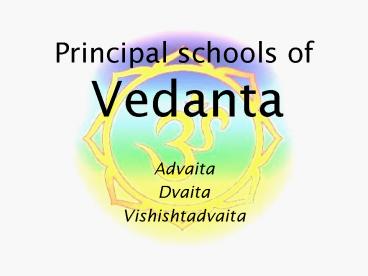Principal schools of Vedanta - PowerPoint PPT Presentation
1 / 15
Title:
Principal schools of Vedanta
Description:
Principal schools of Vedanta Advaita Dvaita Vishishtadvaita Important ideas. Maya; Illusion. Everything that traps you within the illusion that you are not a ... – PowerPoint PPT presentation
Number of Views:478
Avg rating:3.0/5.0
Title: Principal schools of Vedanta
1
Principal schools of Vedanta
- Advaita
- Dvaita
- Vishishtadvaita
2
Important ideas.
- Maya Illusion. Everything that traps you within
the illusion that you are not a spiritual being
is illusory Maya must be overcome in order to
achieve realisation of the way that things really
are. - Moksha Liberation. This is the state that
vedantins aim towards liberation from Maya, and
unity with the ultimate reality.
3
Advaita Vedanta.
- Non-Dual Vedanta. Also called Monist.
- Principal idea is that only Brahman is real,
everything else is maya. - Everything that makes you think that you are an
individual, with distinct existence, in a world
of things, is illusory.
4
Advaita Vedanta
- Moksha is achieved by realising (jñana) that your
atman is Brahman i.e. that you are really
Brahman. - While there is no doubt that you do not perceive
the Existent here, it is not to be doubted that
it is here just the same. What the subtle
essence is, a state of having That as its nature
is this universe That is the real, That is the
self, That art thou Shvetaketu! Chandogya
Upanishad, 613
5
Shankara
- Advaitas principal proponent was Shankara, a
priest of Shiva, who realised that actually,
behind all ideas of the divine lurked an awesome
ultimate reality.
6
3 levels of reality.
- Shankara taught that there are three levels of
reality, through which one must progress in order
to realise Brahman. - 1) The Illusory
- 2) The merely real.
- 3) The really real.
7
The mundane.
- We all accept that there are things that are
illusory dreams, daydreams, hallucinations,
mirages, tricks of the light, tricks of the eye,
etc. - This is the first level of reality that
Shankara identifies.
8
The mundane.
- Most people live in the mundane reality, where
they accept as real only those things which
appear real to the senses. This is also for those
who realise that there is a spiritual component
to existence. They have an individual soul
(Jiva) and worship a personal divinity
(istadevata).
9
The really real.
- Ultimately only Brahman exists, and this
realisation is what will bring moksha, which is
liberation from the illusion of Maya, and an end
to the effects of Karma. - The second stage, of worshipping God is good, but
the true seeker should move beyond it, and
discover ultimate truth.
10
The Snake Story.
- Shankara illustrated this three level theory with
a story a man, going to bed sees a snake beneath
his bed, and cries for help. His servants run in
with lights, and the snake is revealed to be a
coil of rope. None can in fact see that all of
this is Maya!
11
Dvaita Vedanta
- Dual Vedanta. Teaches that two things are real,
and that everything else is Maya. - Taught by Madhva
12
Dvaita Vedanta
- Brahman and atman alone are real, and, while they
are made of the same sort of stuff, they are
distinct and different.
13
Moksha in Dvaita Vedanta
- After working hard at realising your own atman,
moksha is thought of as the raindrop falling into
the ocean two things of the same stuff meeting.
14
Vishishtadvaita Vedanta
- Taught by Ramanuja.
- Qualified non-dualism. Here atman is thought of
as a small part of Brahman that is split off for
the duration of its many life times, moksha sees
the return of the atman to Brahman.
15
Moksha in Vishishtadvaita Vedanta
- Think of a bucket of water taken from the sea,
kept apart for some time, and then returned
something of the same stuff, originating in the
same place, and eventually returning there.































